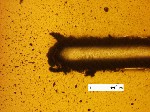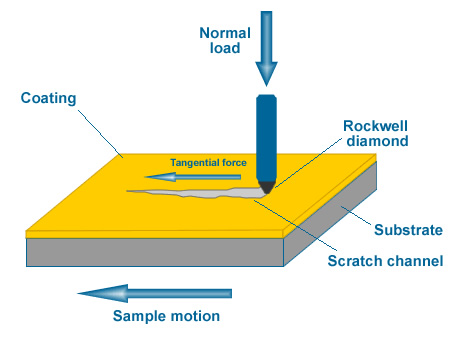
The scratch tester – A simple [relevant-to-adsense type=”start”]thin film coating[relevant-to-adsense type=”stop”] adhesion test
One of the most important properties of a thin film coating is the adhesion (interfacial forces between two surfaces) between the coating and the substrate. The most common method of accurate measurement of thin film coating adhesion is the scratch tester.
Scratch test – basics
A Rockwell diamond tip with a radius of 200µm is moved across the coated surface of a substrate at a constant velocity while a steadily increasing normal force is applied. The diamond causes stress between the thin film coating/substrate interface resulting in delamination or chipping of the coating. The normal force at which the first failure of the coating can be detected is termed the critical load Lc.
Scratch tester – Thin film coating adhesion failure
The typical scratch tester uses three methods to detect thin film coating failure; firstly a load cell is used to measure the change in friction, secondly acoustic emission detects and cracking and thirdly after the test is complete the scratch channel can be viewed using an optical microscope. The intensity of the acoustic emission is dependent on the type of thin film coating failure during the adhesion test e.g. cracking, chipping (cohesive failure) and delamination (adhesive failure). It is therefore good practice to always view the coating failure after the adhesion test using an optical microscope to confirm the critical load.
Scratch tester – Possible substrates
The scratch tester is used to measure thin film coating adhesion on a variety of substrates ranging from metal alloys, semiconductors, glass, and refractive materials but it is easiest to measure the adhesion of hard coatings when they are deposited on substrates with a hardness >54 HRC.

Example of the end of a scratch channel after a scratch test on a TiN thin film coating deposited using magnetron sputtering

